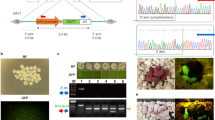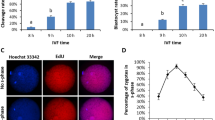Abstract
Zona-free mouse eggs at the pronucleus stage were infected with a replication-defective adenovirus vector containing a nuclear-targeted lacZ gene. Exogenous ß-galactosidase activity was detected in almost all eggs at the two-cell stage. Of 27 mice that developed from infected eggs, three carried the integrated exogenous gene mediated by the adenovirus. Two of the three expressed the lacZ gene, and all three mice transmitted the adenovirus-mediated transgene to F1 progeny Southern blot analysis was consistent with single copy integration. This finding should accelerate the development of new strategies for transgenesis and assist studies on the function of cloned genes in vivo.
This is a preview of subscription content, access via your institution
Access options
Subscribe to this journal
Receive 12 print issues and online access
$209.00 per year
only $17.42 per issue
Buy this article
- Purchase on Springer Link
- Instant access to full article PDF
Prices may be subject to local taxes which are calculated during checkout
Similar content being viewed by others
References
Gordon, J.W. and Ruddle, F.H. 1981. Integration and stable germ line transmission of genes injected into mouse pronuclei. Science 214: 1244–1246.
Gordon, J.W., Scangos, G.A., Plotkin, D.J., Barbosa, J.A., and Ruddle, F.H. 1980. Genetic transformation of mouse embryos by microinjection of purified DMA. Proc. Natl. Acad. Sci. USA 77: 7380–7384.
Pinkert, C.A. 1994. Transgenic animal technology, a laboratory handbook. Academic Press, Inc., San Diego.
Gordon, J.W. 1989. Transgenic animals. Int. Rev. of Cytology 115: 171–229.
Jähner, D., Haase, K., Mulligan, R., and Jaenisch, R. 1985. Insertion of the bacterial gpt gene into the germ line of mice by retroviral infection. Proc. Natl. Acad. Sci. USA 82: 6927–6931.
Jaenisch, R., Jahner, D., Nobis, P., Simon, I., Lohler, J., Harbers, K., et al. 1981. Chromosomal position and activation of retroviral genomes inserted into the germ line of mice. Cell 24: 519–529.
Rosenfeld, M.A., Yoshimura, K., Trapnell, B.C., Yoneyama, K., Rosenthal, E.R., Dalemans, W., et al. 1992. In vivo transfer of the human cystic fibrosis transmem-brane conductance regulator gene to the airway epithelium. Cell 68: 143–155.
Quantin, B., Perricaudet, L.D., Tajbakhsh, S., and Mandel, J.L. 1992. Adenovirus as an expression vector in muscle cells in vivo. Proc. Natl. Acad. Sci. USA 89: 2581–2584.
Le Gal La Salle, G., Robert, J.J., Berrard, S., Ridoux, V., Stratford-Perricaudet, L.D., Perricaudet, M., and Mallet, J. 1993. An adenovirus vector for gene transfer into neurons and glia in the brain. Science 259: 988–990.
Ragot, T., Vincent, N., Chafey, P., Vigne, E., Gilgenkrantz, H., Couton, D., et al. 1993. Efficient adenovirus-mediated transfer of a human minidystrophin gene to skeletal muscle of mdx mice. Nature 361: 647–650.
Chen, S.H., Chen, X.H., Wang, Y., Kosai, K., Finegold, M.J., Rich, S.S., et al. 1995. Combination gene therapy for liver metastasis of colon carcinoma in vivo. Proc. Natl. Acad. Sci. USA 92: 2577–2581.
Sabate, O., Horellou, P., Vigne, E., Colin, P., Perricaudet, M., Buc, C.M., et al. 1995. Transplantation to the rat brain of human neural progenitors that were genetically modified using adenoviruses. Nature Genet. 9: 256–260.
Ginsberg, H.S. 1984. The adenoviruses. Plenum Press, New York.
Horwitz, M.S. 1990. pp. 1679–1742 in Virology, 1. Raven Press, New York.
Zabner, J., Petersen, D.M., Puga, A.R., Graham, S.M., Couture, L.A., Keyes, L.D., et al. 1994. Safety and efficacy of repetitive adenovirus-mediated transfer of CFTR cDNA to airway epithelia of primates and cotton rats. Nature Genet. 6: 75–83.
Crystal, R.G., McElvaney, N.G., Rosenfeld, M.A., Chu, C.S., Mastrangeli, A., Hay, J.G., et al. 1994. Administration of an adenovirus containing the human CFTR cDNA to the respiratory tract of individuals with cystic fibrosis. Nature Genet. 8: 42–51.
Tsukui, T., Miyake, S., Azuma, S., Ichise, H., Saito, I., and Toyoda, Y. 1995. Gene transfer and expression in mouse preimplantation embryos by recombinant adenovirus vector. Mol. Reprod. Dev. 42: 291–297.
Kanegae, Y., Lee, G., Sato, Y., Tanaka, M., Nakai, M., Sakaki, T., et al. 1995. Efficient gene activation in mammalian cells by using recombinant adenovirus expressing site-specific Cre recombinase. Nucleic. Acids. Res. 23: 3816–3821.
Niwa, H., Yamamura, K., and Miyazaki, J. 1991. Efficient selection for high-expression transfectants with a novel eukaryotic vector. Gene 108: 193–199.
Araki, K., Araki, M., Miyazaki, J., and Vassalli, P. 1995. Site-specific recombination of a transgene in fertilized eggs by transient expression of Cre recombinase. Proc. Natl. Acad. Sci. USA 92: 160–164.
Beddington, R.S., Morgernstern, J., Land, H., and Hogan, A. 1989. An in situ transgenic enzyme marker for the midgestation mouse embryo and the visualization of inner cell mass clones during early organogenesis. Development 106: 37–46.
Palmiter, R.D. and Brinster, R.L. 1986. Germ-line transformation of mice. Annu. Rev. Genet. 465–499.
Bishop, J.O. and Smith, P. 1989. Mechanism of chromosomal integration of microinjected DNA. Mol. Biol. Med. 6: 283–298.
Rubenstein, J.L., Nicolas, J.F., and Jacob, F. 1986. Introduction of genes into preimplantation mouse embryos by use of a defective recombinant retrovirus. Proc. Natl. Acad. Sci. USA 83: 366–368.
Visser, L., Wassenaar, A.T., van, M.M., and Rozijn, T.H. 1981. Arrangement of integrated viral DNA sequences in cells transformed by adenovirus types 2 and 5. J. Virol. 39: 684–693.
Dorsch, H.K., Fisher, P.B., Weinstein, I.B., and Ginsberg, H.S. 1980. Patterns of viral DNA integration in cells transformed by wild type or DNA-binding protein mutants of adenovirus type 5 and effect of chemical carcinogens on integration. J. Virol. 34: 305–314.
Hoshi, M. and Toyoda, Y. 1985. Effect of EDTA on the preimplantation development of mouse embryos fertilized in vitro. Jpn. J. Zootech. Sci. 56: 931–937.
Alien, N.D., Cran, D.G., Barton, S.C., Hettle, S., Reik, W., and Surani, M.A. 1988. Transgenes as probes for active chromosomal domains in mouse development. Nature 333: 852–855.
Author information
Authors and Affiliations
Rights and permissions
About this article
Cite this article
Tsukui, T., Kanegae, Y., Saito, I. et al. Transgenesis by adenovirus-mediated gene transfer into mouse zona-free eggs. Nat Biotechnol 14, 982–985 (1996). https://doi.org/10.1038/nbt0896-982
Received:
Accepted:
Issue Date:
DOI: https://doi.org/10.1038/nbt0896-982
This article is cited by
-
Nucleic acids delivery methods for genome editing in zygotes and embryos: the old, the new, and the old-new
Biology Direct (2016)
-
Efficient delivery of DNA into bovine preimplantation embryos by multiwall carbon nanotubes
Scientific Reports (2016)
-
Genomic integration of adenoviral gene transfer vectors following transduction of fertilized mouse oocytes
Transgenic Research (2011)
-
Transfection of oocytes and other types of ovarian cells in rabbits after direct injection into uterine arteries of adenoviruses and plasmid/liposomes
Gene Therapy (2003)
-
Herpesvirus saimiri-based gene delivery vectors maintain heterologous expression throughout mouse embryonic stem cell differentiation in vitro
Gene Therapy (2000)



